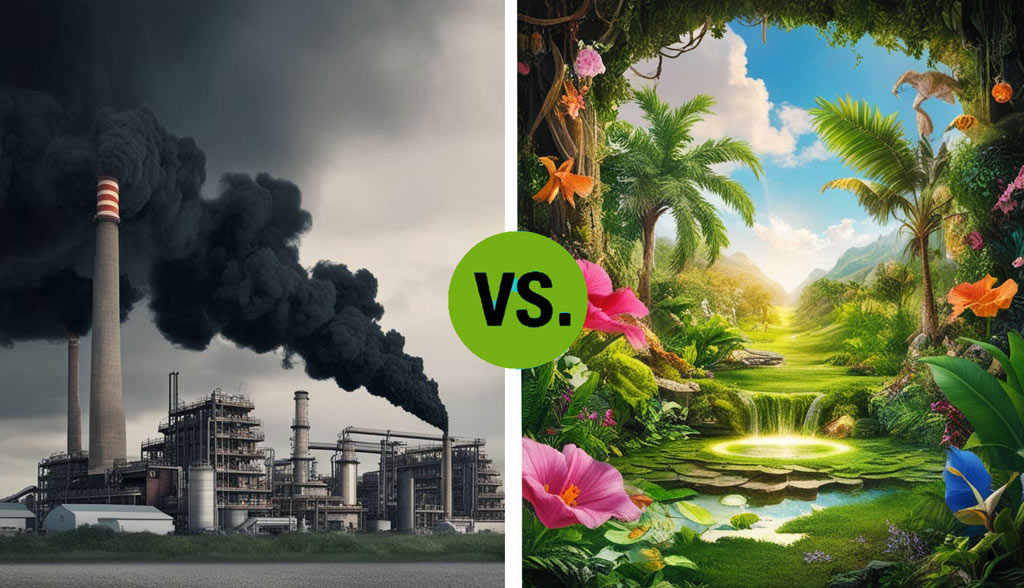Natural vs. Synthetic Perfumes: Which is Better for the Environment?
When it comes to personal fragrances, we often focus on scent profiles and how a perfume makes us feel. But have you ever stopped to consider the environmental impact of your signature scent? As sustainability becomes an increasingly important factor in consumer choices, it’s worth examining how natural perfumes stack up against their synthetic counterparts regarding environmental friendliness. Let’s dive into the world of fragrance production and explore why natural perfumes are the greener choice.
The Basics: Natural vs. Synthetic Perfumes
Before we delve into environmental impacts, let’s clarify what we mean by natural and synthetic perfumes:
Natural perfumes are made primarily from botanical ingredients like essential oils, absolutes, and extracts derived directly from plants, flowers, fruits, and other natural sources. They may also contain animal-derived ingredients like musk or ambergris.
Synthetic perfumes, on the other hand, rely heavily or exclusively on artificial fragrances created in laboratories. These man-made molecules are designed to mimic natural scents or create entirely new ones. While some synthetic perfumes may incorporate tiny drops of natural ingredients, the vast majority of of their scent profile comes from synthetic compounds.
Environmental Considerations
1. Sourcing and Production
Natural perfumes:
- Rely on sustainable agriculture practices
- Support biodiversity
- Often involve traditional harvesting methods
- Have lower energy requirements for production
The ingredients for natural perfumes come directly from nature, often through sustainable farming and wild harvesting practices. This approach can support biodiversity by maintaining diverse plant populations and preserving traditional agricultural knowledge. Many natural perfume ingredients are harvested using time-honored techniques with minimal environmental impact.
For example, the production of rose otto (Rosa Damascena Essential Oil), a prized ingredient in natural perfumery, involves carefully handpicking rose petals and using steam distillation to extract the essential oil. This process requires relatively little energy input compared to the complex chemical reactions needed to create synthetic rose scents.
Synthetic perfumes:
- Require petrochemical inputs
- May involve energy-intensive manufacturing processes
- Can produce hazardous waste byproducts
The production of synthetic fragrances typically starts with petroleum-based raw materials. The manufacturing process can be energy-intensive, involving multiple chemical reactions and purification steps. This reliance on fossil fuels contributes to greenhouse gas emissions and climate change.
Additionally, synthesizing artificial fragrance molecules can generate hazardous waste byproducts that require careful disposal to prevent environmental contamination.
2. Biodegradability and Water Pollution
Natural perfumes:
- Generally biodegradable
- Less likely to accumulate in aquatic ecosystems
Most natural perfume ingredients are biodegradable, meaning they can be broken down by natural processes in the environment. When these fragrances wash off our skin or evaporate into the air, they’re less likely to persist and accumulate in water systems.
For instance, essential oils like lavender or citrus oils will naturally decompose over time when released into the environment. This reduces the risk of long-term water pollution and negative impacts on aquatic life.
Synthetic perfumes:
- May contain nonbiodegradable compounds
- Can accumulate in water systems and harm aquatic life
Some synthetic fragrance molecules are designed to be long-lasting and stable, which also means they can persist in the environment. When these compounds enter waterways through wastewater, they may accumulate over time and potentially harm aquatic ecosystems.
Studies have shown that certain synthetic musks, commonly used in perfumes, can bioaccumulate in fish and other aquatic organisms. This raises concerns about long-term ecological impacts and potential effects on the food chain.
3. Air Quality and Volatile Organic Compounds (VOCs)
Natural perfumes:
- Generally emit fewer harmful VOCs
- May have air-purifying properties
While all perfumes release volatile organic compounds (VOCs) into the air as they evaporate, natural fragrances tend to emit fewer harmful VOCs compared to their synthetic counterparts. Some essential oils used in natural perfumes, like eucalyptus and tea tree, even have air-purifying properties that can help improve indoor air quality.
Synthetic perfumes:
- May emit higher levels of potentially harmful VOCs
- Can contribute to indoor air pollution
Synthetic fragrances often contain a complex mixture of VOCs, some of which may be irritants or potential health hazards when inhaled. The widespread use of synthetic perfumes in homes and public spaces can contribute to indoor air pollution, potentially affecting respiratory health and overall well-being.
4. Packaging and Sustainability
Natural perfumes:
- Often use eco-friendly packaging materials
- May offer refill options to reduce waste
Many natural perfume brands prioritize sustainable packaging, opting for recyclable or biodegradable materials. Glass bottles, which are infinitely recyclable, are a common choice. Some companies even offer refill programs to minimize packaging waste.
For example, some natural perfumers use wooden caps, paper labels, and minimal plastic packaging to reduce their environmental footprint.
Synthetic perfumes:
- Typically rely on conventional packaging materials
- May prioritize luxury presentation over sustainability
While there are exceptions, many mainstream synthetic perfume brands focus more on luxurious presentation than eco-friendly packaging. This frequently results in excessive use of plastics, non-recyclable mixed materials, and decorated boxes that quickly become waste.
5. Ethical Considerations and Animal Testing
Natural perfumes:
- Often cruelty-free and vegan
- May support fair trade and sustainable livelihoods
Many natural perfume brands emphasize ethical production, avoiding animal testing and opting for vegan formulations. By sourcing ingredients directly from small-scale producers, they can support fair trade practices and sustainable livelihoods in farming communities.
Synthetic perfumes:
- May involve animal testing, especially for novel compounds
- Less direct connection to sustainable agriculture
The fragrance industry has made some improvements in reducing animal testing, but the development of new synthetic molecules may still involve animal studies to ensure safety. Additionally, the production of synthetic fragrances has less direct connection to supporting sustainable agricultural practices and rural livelihoods.
The Bigger Picture: Complexity and Nuance
While the points above generally favor natural perfumes in terms of environmental impact, it’s important to acknowledge that the reality is complex. Some considerations:
- Scale of production: Natural ingredients can be resource-intensive to produce in large quantities. The demand for certain natural fragrance materials has led to unsustainable harvesting practices in some cases.
See for example:
- Endangered species: Some prized natural fragrance ingredients come from endangered plants or animals, raising conservation concerns.
See for example:
Musk Deer: the endangered million-dollar animal
Ambergris Perfumes – History, smell, and benefits
Conclusion: Making Informed Choices
As consumers become more environmentally conscious, the choice between natural and synthetic perfumes goes beyond personal preference. Natural perfumes largely offer a more sustainable and eco-friendly option, with benefits ranging from biodegradability to support for sustainable agriculture.
However, it’s crucial to research individual brands and products, as not all natural perfumes are created equal in terms of environmental impact. Look for companies that prioritize sustainable sourcing, ethical production methods, and eco-friendly packaging.
Ultimately, the most environmentally friendly approach to perfume may be to opt for high-quality products with transparent production practices, and support brands that demonstrate a genuine commitment to sustainability.
By making informed choices about our personal care products, including perfumes, we can align our daily habits with our environmental values and contribute to a healthier planet – one spritz at a time.
“La Via del Profumo” perfumes contain only 100% natural products.
Please see our Guaranty of Naturality

























Leave a Reply
Want to join the discussion?Feel free to contribute!